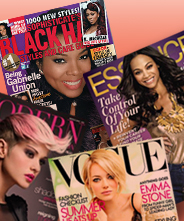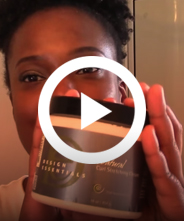
When transitioning from relaxed to natural hair, there are two routes you can take. You can either decide to do the big chop, or you can choose slow transitioning. Slow transitioning is the long process of growing out your relaxed hair, without cutting it, so you still maintain some length.
There are downsides to both routes, but the disadvantage of slow transitioning is that you’ll be able to see the defining line where your naturally curly hair stops and your straight, relaxed hair starts. In other words, half of your head will be looking really curly and the other half will be stick straight.
One huge advantage though to slow transitioning is that it allows you to more comfortably grow out your chemically-processed strands. It’s a lot less scary than the big chop, which will leave you with hardly any hair.
SEE ALSO: PROS AND CONS OF TRANSITIONING FROM RELAXED TO NATURAL
Here’s what the slow transition process looks like-

Source: @_journeytowaistlength

Source: pinimg.com
How to slow transition-
Regardless of whether you choose to big chop or slow transition, your haircare routine is extremely important. If you want to see any healthy hair growth, you must regularly cleanse, condition, and moisturize your strands! Using the right products, you can encourage hair growth. We suggest making this three-part regimen a weekly routine:
- We recommend Coconut and Monoi shampoo because it’s an all natural product that supports your switch toward healthy hair. This shampoo not only keeps your new curls fresh by removing residue, but it’s also ultra-moisturizing.
- Almond and Avocado conditioner is the perfect way to follow up this step. Both almond and avocado are excellent ingredients for providing your natural hair with the hydration and moisture it needs. This conditioner will make your hair feel softer and look shinier.
- Lastly, you should be applying a leave-in conditioner for even more moisture. Can’t get enough of products with natural ingredients? We have one more for you. Kukui and Coconut leave-in conditioner will give your thirsty hair a long-lasting, silky smooth finish.
It’s also a necessity to have your ends trimmed while you’re slow transitioning. This will prevent your hair from getting easily tangled. It will also ensure that split ends don’t travel all the way up your hair shaft, making those strands completely unhealthy and useless.
How to style transitioning hair-
In slow transitioning you fortunately get to keep your hair, but now you have to get creative with what you do to hide that obvious dividing line of textures. Slow transition styles are easier than you think. They not only keep you looking fly, but they enable you to properly care for your newly grown-in, natural hair.
The biggest advantage of transitioning with slow transition styles is that you have the ability to rock your hair in both curly and straight hairstyles like thermal straightening, wet-sets, braids, twists, and braid-outs, to name a few. Here are 3 of the most popular slow transitioning styles.
1. Thermal styling
Transitioning from relaxed to natural hair with thermal styling can be done, but we suggest visiting a professional hairstylist for all silking services to prevent breakage and shedding. Your hair is very weak where the natural hair meets the relaxed hair, so straightening it too much could cause it to easily break or snap.
If you do choose to rock straight hair while transitioning, we recommend using Silk Essentials Thermal Strengthening Serum to protect your hair from heat damage. Pin-curl or wrap your hair nightly, and always sleep with a silk or satin scarf.
2. Wet-Sets
If minimum breakage is your ultimate goal, roller-sets and rod-sets will be your new best friends. Wet-sets like these allow you to manipulate your relaxed ends into coiled patterns, which helps keep the harmony between your natural and relaxed hair.
Not only do these styles look very natural, they also usually last for about two weeks and require very little maintenance. Simply use a satin bonnet at night, unwrap it in the morning, shake out your hair, and mist it with Design Essentials Coconut & Monoi Intense Shine Oil Mist.
3. Braid Outs
Two-strand braid-outs, twist-sets, or bantu knots of any kind are our favorite hairstyles for slow transitioning. They’re very easy to do, and they look the most natural when styled properly. After shampooing and conditioning your hair, use a setting lotion like DE Natural Twist & Set Setting Lotion.
Style your desired braid out, let your hair dry completely, and then untwist your hair. It couldn’t be more simple. For a flawless braid-out, add a roller to the relaxed ends of your braids/twists. If you don’t, those ends will be noticeably stick straight, throwing off your entire style. At nighttime follow the same maintenance steps as you would with a wet-set.
SEE MORE: PROTECTIVE HAIRSTYLES-TRANSITIONING FROM RELAXED TO NATURALLY CURLY HAIR
As you can see, slow transition styles are a good alternative to chopping off all your relaxed hair, so you can wait until you feel comfortable to do so. The big chop isn’t for everyone, and many women decide not to go that route. It’s perfectly normal if you decide to transition to natural hair slowly rather than resorting to the big chop.








